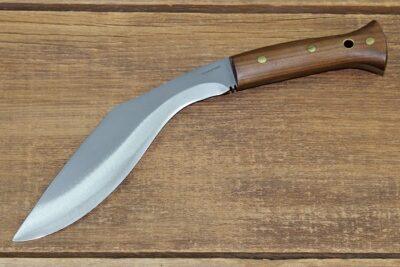There are lots of survival blades out there from machetes and hand-forged skinners to double-bit axes. I’d buy them all if I could, because one can never have too many knives. But then, there’s one particular knife which holds a special place in my heart. It’s a legend among blades, and it’s been that way for hundreds of years. It’s the kukri knife.
I have a few reasons for my affinity of the “kuk.” It’s a special thing when you happen upon a unique bushcraft/survival tool that’s not only beautifully designed, but also has been proven to perform.
This is why, I believe, the kukri knife has found its place in the hearts of bushcrafters and warriors alike. Allow me to elaborate.
The Gurkhas Needed a Chopper, So They Invented One
Some historical records have placed the first known use of a Gurkha kukri knife as far back as the 17th century, and it’s been working for the Nepalese people in Asia ever since.
Its first uses were that of something you might require in the bush, as it was designed to perform just about any task a hunter or farmer would ask of it. The kukri could do basically anything: chopping wood, slaughtering animals for food and clearing away thick foliage that you’d find in the jungles of Nepal. Its “weight-forward” design, where the blade curves away from its user with a disproportionately wide cross section compared to the handle, gives the kukri its famed chopping/slicing power.
This Crazy New Device Can Start A Fire Even In The Worst Conditions
The knife itself was most commonly made no longer than 16 to 18 inches. But due to its incredibly efficient profile, it could out-chop and out-slice blades that were twice its length.
And let’s just say that the Gurkha people noticed this power, applying it to other uses of the more combative persuasion.
Battle Blade: More Than Just a Workhorse
The kukri knife’s military usage has bloodied enemies of the Gurkhas in historic battles from at least as far back as the 19th century.
Of course, the Nepalese Gurkha soldier has always been feared as much as his blade. In trained hands, the kukri knife will glide through flesh and bone in one chopping motion, which is another reason why the kukri has traditionally been made with a hoof-shaped notch above the handle. Aside from religious/ceremonial reasons, the notch keeps the handle clear of blood from enemy soldiers, a horse, a goat, or whatever is bleeding after having come into contact with the rapidly descending business end of the blade.
Because the kukri is such an effectively designed chopper, this means it’s a blade to take very seriously. In fact, the kukri knife even has its own safety rules on proper handling, especially since it will hack through a wrist much like it will hack off a tree limb.
A Blade Designed For Just About Anything
The kukri is made to be your all-purpose farm and bush utility
One of its primary strengths is the fact that it can perform just about any camp task reasonably well. Keep in mind, however, it’s not necessarily up to par with blades that were made specifically for the certain tasks in question. To illustrate this point, here’s a fantastic video review on why the reviewer carries his kukri afield more than most of his other blades:
It can assist you with anything from butchering meat to building shelter. The blade allows me to pack in fewer, more task-specific blades. Opting for the kukri can keep my gear weight down, especially if I’m just on a scout and wish to leave the rest of my gear at camp. I believe that this advantage is explained by one of my original points: the kukri’s primary strength is that it can keep up with the cutting power of a 24-inch machete, even if the blade is half the machete’s size.
Get The Essential Survival Secrets Of The Most Savvy Survivalists In The World!
That makes the kukri knife a weight and function-efficient tool, not to mention the fact that its edge can be maintained easily. Even just a sharpening stone will do the job.
From Gurkha Tradition to the Survival Afield, the Kuk Means Business
It is true that all blades will have their own limitations. And this rule doesn’t necessarily exclude the kuk. I wouldn’t want to use it for cleaning game or any task that requires some semblance of high-precision. But it wasn’t designed to fillet a fish or whittle a toggle.
But there’s certainly something to be said for a blade that’s served the Gurkha people of Nepal for centuries, earning a place of honor in their family traditions, religious ceremonies and even becoming the primary symbol for one of the world’s fiercest military fighting forces. Even in the Middle East, the Gurkhas still fight alongside British forces, soldiers that keep a standard issue kukri knife by their side.
Survivalists are in need of a blade that can make quick work of camp tasks in the field. They also need a weapon that’s been known for its capacity to win a fight. And the kukri knife has been doing that for generations.
Do you have any experience with the kukri knife? What advice would you add? Share your tips in the section below:
Learn How To ‘Live Off The Land’ With Just Your Gun. Read More Here.
 Off The Grid News Better Ideas For Off The Grid Living
Off The Grid News Better Ideas For Off The Grid Living




